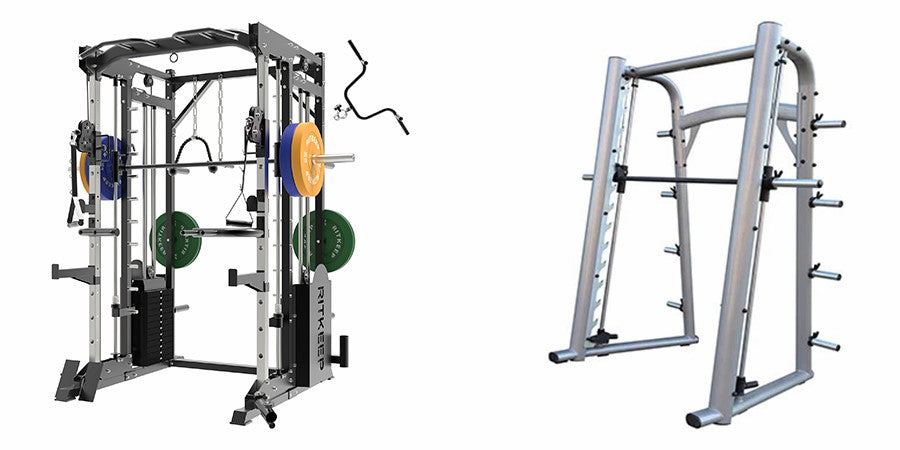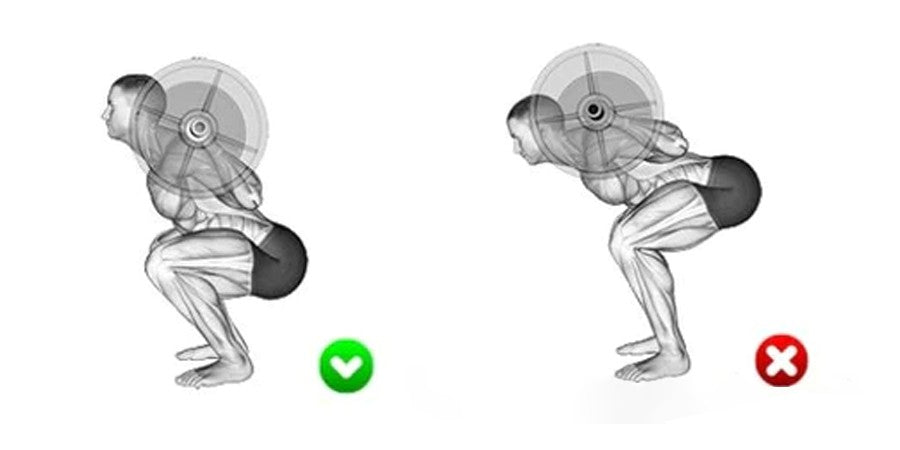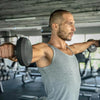How To Use Smith Machine Do Squats: Form, Pros, Cons, & Mistakes To Avoid
You find yourself at the gym, ready for leg day, only to discover that all the power racks are occupied, leaving you a bit frustrated. However, your irritation gives way to curiosity when you spot the Smith machine tucked away in a corner. The challenge arises because you've never attempted a Smith machine squat before.

So, how can you execute a Smith Machine squat correctly? Grasping the proper technique for a Smith machine squat is paramount, as it ensures you extract the maximum benefit from the exercise. Executed incorrectly, not only might you risk injury, but your desired results could also remain elusive.
In this article, we will discuss:
- How To Do Squats On Smith Machine
- Does It Matter Which Way I Face When Using Smith Machine
- How To Program Smith Machine Squats
- Common Mistakes To Avoid On Smith Machine
- What Muscles Do Smith Machine Squats Work On
- Smith Machine Squats Benefits
- Smith Machine Squats Disadvantages
-
Should You Do Smith Machine Squats
How To Do Squats On Smith Machine
Step One: Setup the Smith Machine & Adjust the height of the Bar
Prior to commencing your squats, ensure the proper setup of the Smith machine. This process commences with the positioning of the bar. Position the Smith bar at shoulder level, avoiding placement near your neck. The optimal stance involves situating the barbell on your upper traps and rear deltoids when standing. It's advisable to position it slightly lower than this point, allowing for comfortable lifting without the need to rise onto your toes.
Additionally, confirm that the safety bar is adjusted to knee height. Placing the safety catch at this level grants you ample maneuvering space while maintaining a secure environment. Following this adjustment, proceed to load the bar with weight plates, remember, start with light weight.
Step Two: Standng Position
Position yourself beneath the barbell. The bar should rest comfortably on your traps and rear delts rather than your neck. Place your hands about shoulder-width apart on the bar, adjusting slightly for your comfort. Take a small step forward with your feet, around 3-6 inches from the standard squat stance. This will result in your feet being positioned in front of your knees with your legs extended. However, you can make minor adjustments to determine the optimal position for you.
Step Three: The decent
During your descent, focus on slightly pushing your hips backward as you bend your knees—a movement known as knee flexion. Maintain an upright chest, retract your shoulder blades, and keep your head facing forward. This practice is essential to safeguard the well-being of your spine.
When determining how deep to go, aim for your buttocks to align roughly with your calves at the lowest point, slightly beyond parallel. This position maximizes the beneficial stretching tension in your quadriceps and glutes, crucial for muscle and strength development.
Keep a balanced range of motion—not excessively low, but not overly restricted either. Optimal positioning is a touch past parallel, although achieving a parallel position (thighs aligned with the floor) is also acceptable. When reaching the bottom of the squat, your knees and toes should be almost aligned. Just like in a regular squat, your feet can be placed anywhere between hip and shoulder width, and your toes can be pointing directly forward or slightly angled outward. A slight outward angle might enhance your range of motion.
Step Four: Stand Back Up
When you hit the bottom position, lift upwards using the power from your heels while exhaling. Remember to maintain a straight spine, pointed elbows, and an active core throughout. When you reach the top, your hips should align with a neutral position; however, ensure your knees maintain a gentle bend without locking fully.
Step Five: Complete All Reps & Lock it
When you finish, rotate the bar again so that it locks on one of the safety stops, and exit the Smith machine.
Does It Matter Which Way I Face When Using Smith Machine
RitKeep 5pcs Lat Pull Down Bar Combo |
RitKeep Pull Up Assist Band Set Premium Resistance |
All In One Adjustable Weight Dumbbells |
 |
It depends on the type of Smith machine you're using. On a standard Smith machine, the bar follows a fixed vertical path, resulting in a consistent body angle regardless of your orientation. Therefore, whether you face inward or outward doesn't significantly impact exercises like bench presses, Smith squats, overhead presses, and etc.
However, the story changes with an inclined Smith machine. Here, your facing direction matters due to the angled path of the bar. For instance, during a bench press on the inclined Smith machine, the optimal movement involves pushing the bar up from your lower chest and guiding it back towards your head. This controlled bar path is more aligned with natural movement, ensuring safety and efficacy.
Straight vs Angled Smith Machines
Angled smith machines are commonly set at an incline of 7-12 degrees, which, while maintaining an overall vertical orientation, introduces a slight angle to the bar path. This subtle incline in the bar's trajectory facilitates a more natural route during squats, aligning with the body's movement pattern. The prevalence of angled bar paths in commercial gyms has made them the norm, and they are optimal for exercises like squats and presses due to the enhanced biomechanics they offer.
It's important to remember that an angled Smith machine requires a specific orientation. Unlike a straight-bar version where orientation is less significant, an angled machine demands that your body faces away from the direction of the bar's angle. Selecting the wrong direction will lead to an unnatural motion, placing your joints at a heightened risk of injury. This principle holds true for exercises like overhead presses, squats, lunges, incline bench presses, decline presses, and close-grip bench presses on an inclined Smith machine. It's crucial to prioritize not only correct form but also proper body positioning for these exercises.
How to Program Smith Machine Squats
When integrating the Smith machine squat as a supplementary exercise, it's advisable to slot it into the middle of your workout routine, preferably following your primary squat exercise.
Commence by estimating that your capacity for the Smith machine squat is roughly 60-80% of what you can achieve with free weights. Its purpose is to further enhance the primary muscles involved in free-weight squats, thereby it shouldn't impose the same level of strain as your main lift.
- Rehabilitation: 3 sets of 8 – 12 reps
- Strength: 3 – 5 sets of 4 – 8 reps
- Hypertrophy: 4 – 5 sets of 10 – 20 reps
- Endurance: 5 - 6 sets of 10 – 15 reps
Common Mistakes To Avoid On Smith Machine
Mistake #1: Not Setting Up The Safety Rails Before Starting
The purpose of setting the safety catch is to restrict the downward movement of the bar. It's crucial to ensure that the bar doesn't descend beyond your natural range of motion to prevent potential injuries. To determine the optimal placement of the safety bars for squats, assume the initial position without adding any weights. Lower yourself into a squat and take note of the bar's height in this stance. Then, position the safety bars a few inches below this recorded height.
PMAX-4550 Red & Black Multi Functional Smith Machine |
RitKeep PMAX-5600 Black Multi Functional Smith Machine With Weight Stack |
 |
 |
Mistake #2: Setting the Bar Too High
One of the initial errors often encountered is placing the bar too high on the back before attempting a squat. Those who are new to squatting may mistakenly believe that they should be completely upright and standing when positioning themselves under the bar. Some individuals even go to the extent of rising onto their tiptoes, resembling a calf raise, in order to lift and return the weight to the rack. This approach is hazardous, as it results in improper bar placement on the back at the beginning, necessitating readjustment of foot positioning with the weight unsteadily positioned above. Correctly positioning the bar involves letting it rest below your neck on the upper traps and shoulders.
Mistake #3: Squatting Like You Would With a Barbell
Some individuals attempting to perform a Smith squat in the same manner as a standard squat with standard olympic barbell. It's important to note that in a Smith squat, your feet should be positioned forward, distinct from the placement of your heels under the bar, as seen in a traditional free barbell squat. This distinction arises from the unique bar path characteristic of the Smith machine.
Mistake #4: Leaning Forward
Leaning forward occurs when your hip movement outpaces your knee movement. To prevent this forward lean, engage in slow and controlled movement.

Mistake #5: Completing Reps Too Fast
One most mistake beginners often make when performing squats is rushing through the exercise. If you're new to squats, it's crucial to maintain precision and concentration, which will help you effectively engage your muscles. This is particularly significant during the descent phase, as your ability to control the downward motion serves as a workout in itself. Especially In the context of barbell squats with heavy weights. This deliberate pacing prevents any loss of balance. Such a sensation intentionally slows your movement and encourages a focus on maintaining proper squat form.
Mistake #6: Rounding Your Spine
No matter the variation of squats you perform, it's crucial to avoid arching your spine. This action greatly increases the risk of injury. Instead, maintain a straight back at all times. By actively involving your upper-back muscles through scapula retraction and maintaining an Elevated chest, you can effectively safeguard yourself from harm. Additionally, pay close attention to your foot positioning from the beginning, and refrain from descending too deeply during the squat. These measures will assist you in preventing any rounding of the back and its associated risks.
Mistake #7: Minimizing Your Range of Motion
Hurrying through exercises and prioritizing repetitions over achieving a complete range of motion can diminish the overall impact of your workout. In a research endeavor comparing the outcomes of squat exercises with varying ranges of motion, it was revealed that executing deep squats yielded more significant quadriceps gains. Moreover, in contrast to shallow squats, deep squats prompted advantageous enhancements in both the size and function of the knee extensor muscles.
What Muscles Do Smith Machine Squats Work On
Engaging the quads, and glutes for enhanced buttocks firmness, and calf muscles for well-defined legs. In essence, the exercise primarily focuses on the gluteus maximus, gluteus medius, gluteus minimus, and hip adductors. Additionally, other muscle groups act as supportive entities, aiding in the movement execution.

Quadriceps
Engaging in Smith machine squats effectively targets the quadriceps, a group of four distinct muscles: the rectus femoris, vastus lateralis, vastus medialis, and vastus intermedius.
Comprising a substantial and muscular mass, the quadriceps extend along the entirety of the front and lateral sides of the thighs. These muscles are attached to the knee joint and play a pivotal role in facilitating leg-oriented movements such as standing, walking, running, climbing, and jumping. The extent to which your quads are activated during Smith machine squats, or any other muscle cluster for that matter, hinges on the stance you adopt.
Hip Abductors
Smith machine squats also trigger your hip abductor muscles. This group comprises the gluteus medius, gluteus minimus, and tensor fasciae latae, situated on the outer part of your thighs. Working collaboratively, these muscles provide stability to your pelvis when you're upright and facilitate leg movements such as outward rotation or lateral extension.
Glutes
The glutes play a crucial role in maintaining balance, stride, and overall stability. In contrast, the tensor fasciae latae is linked to the pelvis and contributes to walking, command over movement, and the outward movement of the legs. Your glutes are activated quite well through this action, especially if you have a full range of motion.
Abdominals & Spinae Erectors
Unlike the free-weight squat, the Smith machine squat involves a reduced activation of your abdominal muscles. This is because the machine's design diminishes the requirement for core stability. Nonetheless, your core muscles still play a role to some extent. While your back remains straight and involved, the engagement of your lower back muscles and spine erectors is somewhat diminished. This results in less strain on your lower back muscles, and the intensity is inadequate to effectively target the erector muscles, which are crucial for stability in the conventional free-weight squat.
Calves
Squats also engage the calf muscles in two primary manners: during ankle flexion and for maintaining stability. When using a Smith machine, stability demands are reduced, meaning that calf engagement is primarily tied to ankle movement. In this context, the intensity and depth of your squat play a crucial role: the greater the weight and the lower the squat, the more pronounced the activation of your calf muscles.
Smith Machine Squats Benefits
Benefit #1: Eliminates the need for a spotter
Compared to free weights, the Smith machine offers enhanced user-friendliness. Its fixed and steady bar path eliminates the necessity for balance and the effort required to maintain correct form. A notable advantage is the machine's built-in catch system, encompassing hooks and pins, effectively serving as a spotter. These components facilitate convenient bar racking and unracking throughout your workout sessions. This system significantly reduces the likelihood of sustaining injuries. In contrast, performing free-weight barbell squats demands impeccable form due to the emphasis on stance. In this aspect, the Smith machine shines by aiding in aligning your body within a controlled setting.
Benefit #2: Muscle Isolation
Utilizing the Smith machine provides valuable assistance by alleviating strain on stabilizing muscles, such as the abdominals and erector spinae. Specifically, if your objective centers around targeting a particular muscle group—let's say the quads and glutes due to its adaptable body positioning, which negates the necessity for stabilization. Moreover, the machine offers various adjustments to isolate other muscle groups effectively. The Smith machine's versatility is evident in its use even among professional bodybuilders for squats. Essentially, it presents a compound exercise with isolating attributes, effectively serving as a valuable complementary movement for enhancing overall performance.
Benefit #3: Lift More Weight
Using heavier weights while performing Smith machine squats comes with a catch, as this exercise doesn't accurately reflect your true strength in the squatting motion. However, it's worth noting that you're able to handle more weight on the Smith machine because it eliminates the need to expend energy on stabilizing yourself; the machine takes care of that aspect.
Benefit #4: Reduce unnecessary damage
When performing a standard barbell squat, errors in your form could lead to the engagement of incorrect muscles and an increased risk of muscle injuries. Conversely, the use of a Smith machine provides an opportunity to refine your form. While exercise machines are sometimes viewed as having potential risks, adhering to proper guidelines while utilizing the Smith machine ensures your safety.
Bearing Olympic Powerlifting Barbell |
RAB-3000 Adjustable Inlcine Training Weight Bench |
Olympic Low Bounce Rubber Weight Plates |
 |
Smith Machine Squats Disadvantages
Disadvantage #1: Unnatural Movement & Insufficient Stabilization Strengthening
Exclusive utilization of a Smith machine for squats can lead to the development of unnatural movement patterns. It's important to recognize that a Smith squat diverges significantly from a standard squat. A noteworthy aspect of Smith machines is the absence of immediate feedback. This implies that you could unknowingly execute incorrect movements over an extended period. Furthermore, the absence of stability requirements means that crucial muscles necessary for proper free-weight squats remain underdeveloped. This disparity becomes strikingly evident when transitioning to free-weight squats.
Disadvantage #2: More effective being using Free Weight
Irrespective of one's perspective regarding the Smith machine, research consistently underscores the superiority of free weights. Engaging in free-weight squats leads to comprehensive muscle engagement and significantly higher muscle activation across various groups. Nonetheless, the Smith machine can be employed to target specific muscle clusters, thereby enhancing their activation compared to free-weight squats. This discrepancy arises from the broader and more evenly distributed muscle involvement in free-weight squats.
Should you do Smith Machine Squats
Indeed, incorporating exercises with a free-weight barbell squat is highly beneficial. While some individuals might criticize the Smith Machine, professionals recognize its value, even for squats. The Smith Machine serves as a valuable supplementary workout for the quadriceps, similar to hack squats or leg presses.
However, in cases where Smith Machine squats are the only option due to equipment availability, they can still be effective. It's crucial to ensure a well-rounded leg workout regimen. This involves including exercises for the hamstrings and glutes, such as stiff leg deadlifts or Romanian deadlifts (RDLs) and hip thrusts. Additionally, integrating traditional squats with unrestricted movement (using bodyweight, weights, or dumbbells) and focusing on core strength is essential.
Tag:
RitKeep Home Gym Equipments | Smith Machine For Sales | PMAX-4550 Multi Functional Smith Machine | PMAX-5600 Smith Machine With Dual Weight Stack












